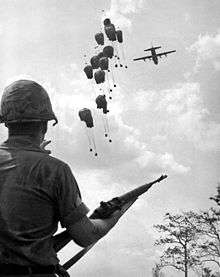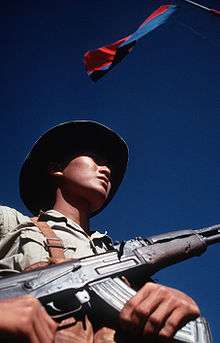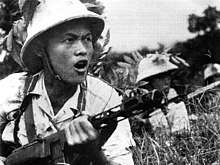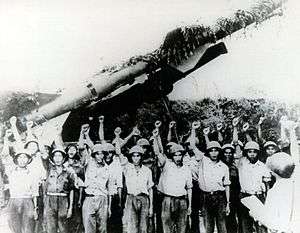Weapons of the Vietnam War
This article is about the weapons used in the Vietnam War, which involved the People's Army of Vietnam (PAVN) or North Vietnamese Army (NVA), National Liberation Front for South Vietnam (NLF) or Viet Cong (VC), and the armed forces of the Army of the Republic of Vietnam (ARVN), United States, Republic of Korea, Philippines, Thailand, and the Australian, New Zealand defence forces, and a variety of irregular troops.
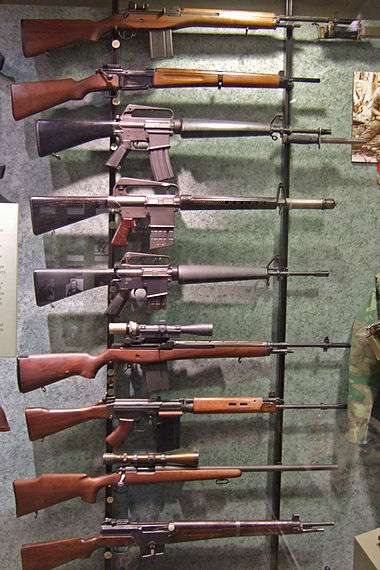
Nearly all United States-allied forces were armed with U.S. weapons including the M1 Garand, M1 carbine, M14 and M16. The Australian and New Zealand forces employed the 7.62 mm L1A1 Self-Loading Rifle as their service rifle, with the occasional US M16.
The PAVN, although having inherited a variety of American, French, and Japanese weapons from World War II and the First Indochina War (aka French Indochina War), were largely armed and supplied by the People's Republic of China, the Soviet Union, and its Warsaw Pact allies. In addition, some weapons—notably anti-personnel explosives, the K-50M (a PPSh-41 copy), and "home-made" versions of the RPG-2—were manufactured in North Vietnam. By 1969 the US Army had identified 40 rifle/carbine types, 22 machine gun types, 17 types of mortar, 20 recoilless rifle or rocket launcher types, nine types of antitank weapons, and 14 anti-aircraft artillery weapons used by ground troops on all sides. Also in use, primarily by anti-communist forces, were the 24 types of armored vehicles and self-propelled artillery, and 26 types of field artillery and rocket launchers.
Communist forces and weapons
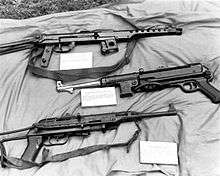
During the early stages of their insurgency, the Viet Cong mainly sustained itself with captured arms (often of American manufacture)[1] or crude, self-made weapons (e.g. copies of the US Thompson submachine gun[2] and shotguns made of galvanized pipes).[3] Most arms were captured from poorly defended ARVN militia outposts.[4]
Communist forces were principally armed with Chinese and Soviet weaponry though some VC guerrilla units were equipped with Western infantry weapons either captured from French stocks during the first Indochina war, such as the MAT-49, or from ARVN units or requisitioned through illicit purchase.
In the summer and fall of 1967, all Viet Cong battalions were reequipped with arms of Soviet design such as the AK-47 assault rifle and the RPG-2 anti-tank weapon.[5] Their weapons were principally of Chinese[6] or Soviet manufacture.[7] The period up to the conventional phase in the 1970, the Viet Cong and NVA were primarily limited to mortars, recoil-less rifles and small-arms and had significantly lighter equipment and firepower in comparison with the US arsenal, relying on ambushes alongside superior stealth, planning, marksmanship and small-unit tactics to face the disproportionate US technological advantage.[8]
Many divisions within the NVA would incorporate armoured and mechanised battalions including the Type 59 tank., BTR-60, Type 60 artillery and rapidly altered and integrated new war doctrines following the Tet Offensive into a mobile combined-arms force.[9] The North Vietnamese had both amphibious tanks (such as the PT-76) and light tanks (such the Type 62) used during the conventional phase. Experimental Soviet equipment started being used against ARVN forces at the same time, including Man-portable air-defense system SA-7 Grail and anti-tank missiles including the AT-3 Sagger.[10] By 1975 they had fully transformed from the strategy of mobile light-infantry and using the people's war concept used against the United States.[9]
US weapons
The American M16 rifle and XM177 carbine, which both replaced the M14, was lighter and considered more accurate than the AK-47 but was prone to malfunction. Often the gun suffered from a malfunction known as "failure to extract", which meant that the spent cartridge case remained lodged in the chamber after a round was fired. According to a congressional report, the malfunction was caused by a change of gunpowder in the ammunition, which was done without adequate testing and by a money saving policy, headed by Robert McNamara, to not issue adequate cleaning kits to soldiers. This led to a myth of a self-cleaning gun. These decisions were made without regard to the safety of soldiers and resulted in many deaths.
The heavily armored, 90 mm gun M48A3 'Patton' tank saw extensive action during the Vietnam War and over 600 were deployed with U.S. forces. They played an important role in infantry support though there were a few tank versus tank battles. The M67A1 flamethrower tank (nicknamed the Zippo) was an M48 variant used in Vietnam. Artillery was used extensively by both sides but the Americans were able to ferry the lightweight 105 mm M102 howitzer by helicopter to remote locations on quick notice.[11][12] With its 17-mile (27 km) range, the Soviet 130 mm M-46 towed field gun was a highly regarded weapon and used to good effect by the PAVN. It was countered by the long-range, American 175 mm M107 Self-Propelled Gun.[13]
The United States had air superiority though many aircraft were lost to surface-to-air missiles and anti-aircraft artillery. U.S. airpower was credited with breaking the siege of Khe Sanh and blunting the 1972 Easter Offensive against South Vietnam. At sea, the U.S. Navy had the run of the coastline, using aircraft carriers as platforms for offshore strikes and other naval vessels for offshore artillery support. Offshore naval fire played a pivotal role in the Battle of Huế in February 1968, providing accurate fire in support of the U.S. counter-offensive to retake the city.[14]
The Vietnam War was the first conflict that saw wide scale tactical deployment of helicopters.[15] The Bell UH-1 Iroquois nicknamed "Huey" was used extensively in counter-guerilla operations both as a troop carrier and a gunship.[12] In the latter role it was outfitted with a variety of armaments including M60 machine guns, multi-barreled 7.62 mm Miniguns and unguided air-to-surface rockets.[12] The Hueys were also successfully used in MEDEVAC and search and rescue roles.[12] Two aircraft which were prominent in the war were the AC-130 "Spectre" Gunship and the UH-1 "Huey" gunship. The AC-130 was a heavily armed ground-attack aircraft variant of the C-130 Hercules transport plane; it was used to provide close air support, air interdiction and force protection. The AC-130H "Spectre" was armed with two 20 mm M61 Vulcan cannons, one Bofors 40mm autocannon, and one 105 mm M102 howitzer. The Huey is a military helicopter powered by a single, turboshaft engine, and approximately 7,000 UH-1 aircraft saw service in Vietnam. At their disposal ground forces had access to B-52 and F-4 Phantom II and others to launch napalm, white phosphorus, tear gas and chemical weapons as well.[16] The aircraft ordnance used during the war included precision-guided munition, cluster bombs, a thickening/gelling agent generally mixed with petroleum or a similar fuel for use in an incendiary device, initially against buildings and later primarily as an anti-personnel weapon that sticks to skin and can burn down to the bone.
The Claymore M18A1, an anti-personnel mine was widely used, and is command-detonated and directional shooting 700 steel pellets in the kill zone.
Weapons of the South Vietnamese, U.S., South Korean, Australian, and New Zealand Forces
Hand combat weapons
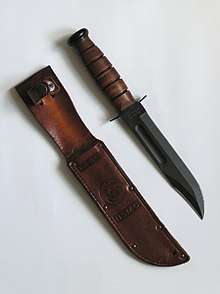
- L1A1 and L1A2 bayonets - used on L1A1 Self-Loading Rifle[17]
- M1905 bayonet - used on the M1 Garand.[18]
- M1917 bayonet - used on various shotguns.[17]
- M1 Bayonet - used on the M1 Garand.[18]
- M3 fighting knife[19]
- M4 bayonet - used on the M1 and M2 Carbine.[17]
- M5 bayonet - used on the M1 Garand.[17]
- M6 bayonet - used on the M14.[17]
- M7 Bayonet - used on the M16.[17]
- Ka-Bar Utility/fighting Knife - used by the US Army, Navy and Marine Corps.[20][21]
- Gerber Mark II U.S. Armed Forces
- Randall Made Knives - personally purchased by some US soldiers.[22]
- M1905,M1917,M1 and Lee Enfield bayonets cut down and converted in to fighting knives.
- Bow - used by US Mobile Riverine Force.[23]
- Crossbow - used by South Vietnamese Montagnards[24]
Pistols and revolvers
- Colt M1911A1 – standard US and ARVN sidearm.[25][26]
- Browning Hi-Power – used by Australian and New Zealand forces (L9 pistol).[27] Also used on an unofficial basis by US reconnaissance and Special Forces units.[28]
- Colt Model 1903 Pocket Hammerless – carried by US military officers. Replaced by the Colt Commander in the mid-1960s
- Colt Detective Special - .38 Special revolver, used by some ARVN officers[26]
- Colt Police Positive Special - .38 Special revolver, used by USAF and tunnel rats[29]
- High Standard HDM – Integrally suppressed .22LR handgun, supplemented by the Mark 22 Mod 0 in the later stages of the war.[30]
- Ingram MAC-10 – automatic pistol used by US special operations forces.[30]
- Luger P08 - CIA provided pistol[31]
- M1917 revolver – .45 ACP revolver[32] used by the South Vietnamese and US forces during the beginning of the war alongside the Smith & Wesson Model 10. Used rather prominently by tunnel rats.
- Quiet Special Purpose Revolver - 40. revolver used by tunnel rats.
- Smith & Wesson Model 10 – .38 Special revolver used by ARVN,[33] by US Army and USAF pilots[34] and by tunnel rats[29]
- Smith & Wesson Model 12 – .38 Special revolver carried by US Army and USAF pilots.
- Smith & Wesson Model 15 – .38 Special revolver carried by USAF Security Police Units.
- Colt Python – .357 Magnum revolver carried by MACVSOG.
- Smith & Wesson Model 27 – .357 Magnum revolver carried by MACVSOG.
- Smith & Wesson Mark 22 Mod.0 "Hush Puppy" – Suppressed pistol used by US Navy SEALs and other U.S. special operations forces.[30]
- Walther P38 - CIA provided pistol[31]
Infantry rifles
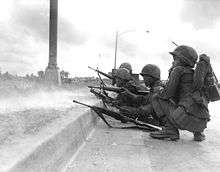
- L1A1 Self-Loading Rifle – used by Australian and New Zealand soldiers in Vietnam[35]
- M1 Garand – used by the South Vietnamese[36] and South Koreans[37]
- M1, M1A1, & M2 Carbine – used by the South Vietnamese Military, Police and Security Forces,[36] South Koreans,[38] U.S. military, and Laotians supplied by the U.S.
- M14 rifle - issued to most U.S. troops from the early stages of the war until 1967–68, when it was replaced by the M16.[38]
- M16, XM16E1, and M16A1 – M16 was issued in 1964, but due to reliability issues, it was replaced by the M16A1 in 1967 which added the forward assist and chrome-lined barrel to the rifle for increased reliability.[39]
- CAR-15 – carbine variant of the M16 produced in very limited numbers, fielded by special operations early on. Later supplemented by the improved XM177.
- XM177 (Colt Commando)/GAU-5 – further development of the CAR-15, used heavily by MACV-SOG, the US Air Force, and US Army.[30]
- Stoner 63 – used by US Navy SEALs and USMC.[30]
- T223 – a copy of the Heckler & Koch HK33 built under license by Harrington & Richardson used in small numbers by SEAL teams. Even though the empty H&R T223 was 0.9 pounds (0.41 kg) heavier than an empty M16A1, the weapon had a forty-round magazine available for it and this made it attractive to the SEALS.[30]
- MAS-36 rifle - used by South Vietnamese militias[40]
- AK-47, AKM and Type 56 - Captured rifles were used by South Vietnamese[41] and U.S forces.[42][43]
Sniper/marksman rifles
- M1C/D Garand and MC52 - used by CIA advisors, the USMC and the US Navy early in the war.[44][45] Approximately 520 were supplied to the ARVN and 460 to the Thai forces.[46]
- M1903A4 Springfield – used by the USMC early in the war, replaced by the M40.[45]
- M21 Sniper Weapon System – sniper variant of the M14 rifle used by the US Army.[47]
- M40 (Remington Model 700)– bolt-action sniper rifle meant to replace the M1903A4 Springfield rifle and Winchester Model 70; used by the USMC[45]
- Parker-Hale M82 - used by ANZAC forces[27]
- Winchester Model 70 – used by the USMC[45]
- Mosin Nagant - used by South Vietnamese militias
Submachine guns
- Beretta M12 – limited numbers were used by U.S. Embassy security units.[48]
- Carl Gustaf m/45 – used by Navy SEALs in the beginning of the war, but later replaced by the Smith & Wesson M76 in the late 1960s. Significant numbers were also utilized by the South Vietnamese,[30] and limited numbers were used in Laos by advisors, and Laotian fighters.
- Smith & Wesson M76 – copy of the Carl Gustaf m/45. Few were actually shipped to Navy SEALs fighting in Vietnam.[49]
- F1 submachine gun – replaced the Owen Gun in Australian service.[50][51]
- M3 Grease gun – standard U.S. military submachine gun, also used by the South Vietnamese[30][52]
- M50/55 Reising – limited numbers were used by MACVSOG and other irregular forces.[30]
- Madsen M-50 – used by South Vietnamese forces, supplied by the CIA.[52]
- MAS-38 submachine gun - used by South Vietnamese militias.[53]
- MAT-49 submachine gun – used by South Vietnamese militias.[40] Captured models were used in limited numbers[30]
- MP 40 submachine gun - used by South Vietnamese forces, supplied by the CIA.[52]
- Owen Gun – standard Australian submachine-gun in the early stages of the war, later replaced by the F1.[50][51]
- Sten submachine gun – used by US special operations forces, often with a suppressor mounted.[42]
- Sterling submachine gun – used by Australian Special Air Service Regiment and other special operations units.[51]
- Thompson submachine gun – used often by South Vietnamese troops, and in small quantities by US artillery and helicopter units.
- Uzi – used by special operations forces and some South Vietnamese, supplied from Israel.[42]
Shotguns
Shotguns were used as an individual weapon during jungle patrol; infantry units were authorized a shotgun by TO&E (Table of Organization & Equipment). Shotguns were not general issue to all infantrymen, but were select issue weapons, such as one per squad, etc.
- Ithaca 37 – pump-action shotgun used by the United States and ARVN.[30][54]
- Remington Model 10 – pump-action shotgun used by the United States.[55]
- Remington Model 11-48 - semi-automatic shotgun used by US Army.[56]
- Remington Model 31 – pump-action shotgun used by the US Army, the SEALs and the ARVN.[56][57]
- Remington Model 870 – pump-action shotgun primary shotgun used by Marines, Army and Navy after 1966.[30][56][58]
- Remington 7188 – experimental select fire shotgun, withdrawn due to lack of reliability. Used by US Navy SEALs[30][59]
- Savage Model 69E - pump-action shotgun used by the US Army.[34]
- Savage Model 720 - semi-automatic shotgun.[60]
- Stevens Model 77E – pump-action shotgun used by Army and Marine forces. Almost 70,000 Model 77Es were procured by the military for use in SE Asia during the 1960s.[61] Also very popular with the ARVN because of its small size.[62]
- Stevens Model 520/620[54]
- Winchester Model 1912 - used by USMC.[63]
- Winchester Model 1200 – pump-action shotgun used by the US Army.[64]
- Winchester Model 1897 – used by the Marines during the early stages of the war.[65]
Machine guns
- M60 machine gun – standard General-purpose machine gun for US, ANZAC, and ARVN forces throughout the war.[50]
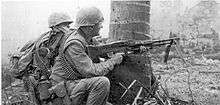
- Colt Machine Gun – experimental light machine gun deployed by SEAL Team 2 in 1970.[30]
- M1918 Browning Automatic Rifle – used by the ARVN during the early stages of the war,[66] as well as many that were airdropped into Laos and used by Laotian fighters.
- FM 24/29 light machine gun - used by South Vietnamese militias[40]
- RPD machine gun (and Type 56) - captured and used by reconnaissance teams of Mobile Strike Forces, MAC-V-SOG and other special operation forces. Also commonly modified, a common modification was to cut down the barrel.[43]
- Stoner M63A Commando & Mark 23 Mod.0 – used by Navy SEALs and tested by Force Recon.[30]
- M134 Minigun - 7.62 mm vehicle mounted machine gun (rare)[67]
- M1917 Browning machine gun – .30cal heavy machine gun issued to the ARVN and also in limited use by the U.S. Army.
- M1919 Browning machine gun (and variants such as M37) – vehicle mounted machine gun.[68] Meanwhile, still of use by many South Vietnamese infantry.[27]
- M73 machine gun – tank mounted machine gun.[68]
- Browning M2HB .50cal Heavy Machine Gun[30]
Grenades and mines
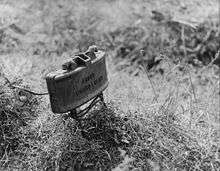
- AN-M8 - white smoke grenade[69][70]
- C4 explosive[71]
- Mark 2 fragmentation grenade[72]
- M1 smoke pot[71]
- M26 fragmentation grenade and many subvariants[73][74]
- M59 and M67 fragmentation grenade[75][76]
- M6/M7-series riot control grenades[70] - Used to clear NVA/VC out of caves, tunnels and buildings[77] or stop a pursuer.[69]
- AN/M14 TH3 thermite grenade - Incendiary grenade used to destroy equipment and as a fire-starting device.[69]
- M15 and M34 smoke grenades - filled with white phosphorus,[22] which ignites on contact with air and creates thick white smoke.[69] Used for signalling and screening purposes, as well as an anti-personnel weapon in enclosed spaces, as the burning white phosphorus would rapidly consume any oxygen, suffocating the victims.
- M18 grenade Smoke Hand Grenade - Signaling/screening grenade available in red, yellow, green, and purple.[78][69]
- V40 Mini-Grenade[79]
- OF 37 grenade and DF 37 grenade, French grenades used by the ARVN in the 1950s[80][81]
- XM58 riot control grenade - A miniature riot control grenade used by MACVSOG and Navy SEALs.[77]
- M14 mine - anti-personnel blast mine[22]
- M15 mine - anti-tank mine[82]
- M16 mine - bounding anti-personnel fragmentation mine[82]
- M18/M18A1 Claymore - command-detonated directional anti-personnel mine[26][83]
- M19 mine - anti-tank mine[82]
Grenade and Rocket Launchers
- M1/M2 rifle grenade adapters - used to convert a standard fragmentation grenade (M1) or smoke grenade (M2) into a rifle grenade in conjunction with the M7 grenade launcher.
- M7 and M8 rifle grenade launcher - rifle grenade launcher used with respectively the M1 Garand and the M1 carbine, used by the South Vietnamese. Could fire the M9 and M17 rifle grenades.[84]
- M31 HEAT rifle grenade – Used primarily by the U.S. Army before the introduction of the M72 LAW. Fired from the M1 Garand and M14 Rifle.
- M79 Grenade Launcher - primary U.S. grenade launcher used by all branches of the US military, as well as ANZAC forces and the ARVN.[30][84]
- China Lake Grenade Launcher - pump action weapon used in very small numbers.[30]
- XM148 - experimental underbarrel 40mm grenade launcher that could be attached to the M16 rifle or XM177 carbine. Withdrawn due to safety reasons.[30][84]
- M203 grenade launcher - single-shot 40mm underslung grenade launcher designed to attach to a M16 rifle (or XM177 carbine, with modifications to the launcher). First tested in combat April 1969.[30][84]
- Mark 18 Mod 0 grenade launcher - Hand-cranked, belt-fed, 40x46mm grenade launcher used by the US Navy.[85]
- Mark 19 grenade launcher - Automatic, belt-fed, 46x53mm grenade launcher.[85]
- Mk 20 Mod 0 grenade launcher - Automatic, belt-fed, 40x46mm grenade launcher. Primarily used by riverine crews but also used by Air Force Special Operations.[85]
- XM174 grenade launcher - Automatic, belt-fed, 40x46mm grenade launcher used mainly by the US Army.[86]
- Bazooka - The M9 variant was supplied to the ARVN during the early years of the war,[87] while the M20 "Super Bazooka" was used by the USMC and the ARVN until the full introduction of the M67 90mm recoilless rifle and of the M72 LAW.[88]
- M72 LAW – 66mm anti-tank rocket launcher.[89]
- XM202 - experimental four-shot 66mm incendiary rocket launcher.[90]
- FIM-43 Redeye MANPADS (Man-Portable Air-Defence System) – shoulder-fired heat-seeking anti-air missile, used by the US Army and USMC.
- BGM-71 TOW - wire-guided anti-tank missile[91]
Flamethrowers
Infantry support weapons

- M18 recoilless rifle - 57mm shoulder-fired/tripod mounted recoilless rifle, used by the ARVN early in the war.[94]
- M20 recoilless rifle - 75mm tripod/vehicle-mounted recoilless rifle, used by US and ARVN forces early in the war.[95]
- M67 recoilless rifle - 90mm shoulder-fired anti-tank recoilless rifle, used by the US Army, US Marine Corps, ANZAC and ARVN selected forces.[95][96][97]
- M40 recoilless rifle 106mm tripod/vehicle-mounted recoilless rifle.[95][96]
- M2 mortar - 60mm mortar, used in conjunction with the lighter but less accurate and lower-range M19 mortar.[98]
- M19 mortar - 60mm mortar, used in conjunction with the older, heavier M2 mortar.[98][99]
- Brandt Mle 27/31 - 81mm mortar, used by ARVN forces[100]
- M1 mortar - 81mm mortar, used by ARVN forces.[100]
- M29 mortar - 81mm mortar, used by US and ARVN forces.[100][101]
- L16A1 mortar - 81mm, used by ANZAC forces.[50]
- 82-BM-37 - captured 82mm mortar, few used by USMC with US rounds.[102]
- M30 mortar 107mm mortar, used by US and ARVN forces.[103][34]
- M98 Howtar, variant of the latter mounted on a M116 howitzer carriage.[104]
Artillery
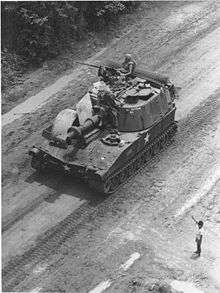
- M55 quad machine gun - used to defend US Army bases and on vehicles[105][106]
- Oerlikon 20 mm cannon - used on riverine crafts[107]
- Bofors 40 mm gun - used on riverine crafts[107]
- 105 mm Howitzer M101A1/M2A1[108][105]
- 105 mm Howitzer M102[109][105]
- 155 mm Howitzer M114[105][110]
- M53 Self-propelled 155mm gun[111]
- M55 Self-propelled 8-inch howitzer[111]
- M107 Self-propelled 175mm gun[105][112][113]
- M108 Self-propelled 105 mm howitzer[105]
- M109 Self-propelled 155 mm howitzer[114]
- M110 Self-propelled 8-inch howitzer[105][112]
- 75mm Pack Howitzer M1
- L5 pack howitzer 105 mm pack howitzer used by Australia[115] and New Zealand[116]
- MIM-23 Hawk - medium-range surface to air missile used in very small quantities by the US Marines.[117]
Artillery ammunition types
- HE (High Explosive) - standard artillery round.[118]
- High-explosive anti-tank round - fired by 105mm guns.[118]
- White phosphorus - used for screening or incendiary purposes.[118]
- Smoke shells - used for screening.[118]
- Leaflet shell - rarely used.[118]
- Beehive flechette rounds - antipersonnel rounds.[119]
- Improved Conventional Munition - antipersonnel shell with sub-munitions.[120]
Aircraft
(listed alphabetically by modified/basic mission code, then numerically in ascending order by design number/series letter)
- A-1 Skyraider - ground attack aircraft[121]
- A-3 Skywarrior - carrier-based bomber[122]
- A-4 Skyhawk - carrier-based strike aircraft[123]
- A-6 Intruder - carrier-based all weather strike aircraft[124]
- A-7 Corsair II - carrier-based strike aircraft[125]
- A-26 Invader - light bomber[126]
- A-37 Dragonfly - ground attack aircraft[127]
- AC-47 Spooky - gunship[128]
- AC-119G "Shadow" - gunship[129]
- AC-119K "Stinger" - gunship[129]
- AC-130 "Spectre" - gunship[130]
- AU-23 Peacemaker - ground attack aircraft
- AU-24 Stallion - ground attack aircraft[131]
- B-52 Stratofortress - heavy bomber[132]
- B-57 Canberra - medium bomber[133]
- Canberra B.20 - Royal Australian Air Force medium bomber[133]
- C-1 Trader - cargo/transport aircraft
- C-2 Greyhound - cargo/transport aircraft
- C-5 Galaxy - strategic lift cargo aircraft[134]
- C-7 Caribou - tactical cargo aircraft, used by the U.S. Air Force, the Royal Australian Air Force and the South Vietnamese Air Force[135]
- C-46 Commando - cargo/transport aircraft[136]
- C-47 - cargo/transport aircraft[128]
- C-54 - transport aircraft[136]
- C-97 Stratofreighter - cargo/transport aircraft
- C-119 Boxcar - cargo/transport aircraft[129]
- C-121 Constellation - transport aircraft[137]
- C-123 Provider - cargo/transport aircraft[138]
- C-124 Globemaster II - cargo/transport aircraft[139]
- C-130 Hercules - cargo/transport plane[130]
- C-133 Cargomaster - cargo/transport aircraft[140]
- C-141 Starlifter - strategic cargo aircraft[141]
- E-1 Tracer - carrier-based airborne early warning (AEW) aircraft[142]
- E-2 Hawkeye - carrier-based airborne early warning (AEW) aircraft[142]
- EA-3 Skywarrior - carrier-based tactical electronic reconnaissance aircraft[122]
- EA-6B Prowler - carrier-based electronic warfare & attack aircraft[124]
- EB-57 Canberra - tactical electronic reconnaissance aircraft[133]
- EB-66 - tactical electronic reconnaissance aircraft[122]
- EC-121 - radar warning or sensor relay aircraft[137]
- EF-10 Skyknight - tactical electronic warfare aircraft[143]
- EKA-3B Skywarrior - carrier-based tactical electronic warfare aircraft[122]
- F-4 Phantom II - carrier and land based fighter-bomber[144]
- F-5 Freedom Fighter - light-weight fighter used in strike aircraft role[145]
- F8F Bearcat - piston fighter-bomber, used by the South Vietnamese Air Force until 1964.[146]
- F-8 Crusader - carrier and land based fighter-bomber[147]
- F-14 Tomcat - carrier-based fighter, made its combat debut during Operation Frequent Wind, the evacuation of Saigon, in April 1975.[148]
- F-100 Super Sabre - fighter-bomber[149]
- F-102 Delta Dagger - fighter[150]
- F-104 Starfighter - fighter[150]
- F-105 Thunderchief - fighter-bomber[151]
- F-111 Aardvark - medium bomber[152]
- HU-16 Albatross - rescue amphibian[153]
- KA-3 Skywarrior - carrier-based tactical aerial refueler aircraft[122]
- KA-6 Intruder - carrier-based tactical aerial refueler aircraft[124]
- KB-50 Superfortress - aerial refueling aircraft
- KC-130 Hercules - tactical aerial refueler/assault transport aircraft[154]
- KC-135 Stratotanker - aerial refueling aircraft[155]
- O-1 Bird Dog - light observation airplane[156]
- O-2 Skymaster - observation aircraft[157]
- OV-1 Mohawk - battlefield surveillance and light strike aircraft[158]
- OV-10 Bronco - light attack/observation aircraft[159]
- P-2 Neptune - maritime patrol aircraft[160]
- P-3 Orion - maritime patrol aircraft[161]
- P-5 Marlin - antisubmarine seaplane[162]
- QU-22 Pave Eagle (Beech Bonanza) - electronic monitoring signal relay aircraft[161]
- RA-3B Skywarrior - carrier-based tactical photographic reconnaissance aircraft[122]
- RA-5C Vigilante - carrier-based tactical photographic reconnaissance aircraft[163]
- RB-47 Stratojet - photographic reconnaissance aircraft[164]
- RB-57 Canberra - tactical photographic reconnaissance aircraft[133]
- RB-66 - tactical photographic reconnaissance aircraft[122]
- RF-4 Phantom II - carrier and land-based tactical photographic reconnaissance aircraft[144]
- RF-8 Crusader - carrier-based tactical photographic reconnaissance aircraft[147]
- RF-101 Voodoo - tactical photographic reconnaissance aircraft[165]
- RT-33A - reconnaissance jet[166]
- S-2 Tracker - carrier-based anti-submarine warfare (ASW) aircraft
- SR-71 Blackbird - strategic reconnaissance aircraft[167]
- TF-9J Cougar - fast forward air controller
- T-28 Trojan - trainer/ground attack aircraft[168]
- T-41 Mescalero - trainer aircraft[169]
- U-1 Otter - transport aircraft[170]
- U-2 - reconnaissance aircraft[171]
- U-6 Beaver - utility aircraft[161]
- U-8 Seminole - transport/electronic survey aircraft[170][172]
- U-10 Helio Courier - utility aircraft[161]
- U-17 Skywagon - utility aircraft[173]
- U-21 Ute - liaison and electronic survey[170][172][174]
- YO-3 Quiet Star - light observation airplane[175]
_at_anchor_in_the_Mekong_Delta_ca_late_1960s.jpg)
Helicopters
(listed numerically in ascending order by design number/series letter, then alphabetically by mission code)
- UH-1 Iroquois "Huey" - utility transport and gunship helicopter[176][177]
- AH-1G HueyCobra - attack helicopter[177]
- AH-1J SeaCobra - twin-engine attack helicopter[177]
- UH-1N Iroquois - twin-engine utility helicopter[178]
- UH-2 Seasprite - carrier-based utility helicopter[179][180]
- CH-3 Sea King - long-range transport helicopter[181]
- HH-3 "Jolly Green Giant" - long-range combat search and rescue (CSAR) helicopter[181]
- SH-3 Sea King - carrier-based anti-submarine warfare (ASW) helicopter[181]
- OH-6A Cayuse "Loach" (from LOH - Light Observation Helicopter) - light transport/observation (i.e. scout) helicopter[182][183]
- OH-13 Sioux - light observation helicopter[176]
- UH-19 Chickasaw - utility transport helicopter[176]
- CH-21 Shawnee - cargo/transport helicopter[176]
- OH-23 Raven - light utility helicopter[176]
- CH-34 Choctaw - cargo/transport helicopter[176][184]
- CH-37 Mojave - cargo/transport helicopter[176]
- HH-43 Huskie - rescue helicopter[182][185]
- CH-46 Sea Knight - cargo/transport helicopter[179][186]
- CH-47 Chinook - cargo/transport helicopter[187][188]
- CH-53 Sea Stallion - heavy-lift transport helicopter[179][189]
- HH-53 "Super Jolly Green Giant" - long-range combat search and rescue (CSAR) helicopter[189]
- CH-54 Tarhe "Sky Crane" - heavy lift helicopter[187][190]
- OH-58A Kiowa - light transport/observation helicopter[182]
Aircraft ordnance
- GBUs
- CBUs
- BLU-82 Daisy cutter
- Napalm
- Bomb, 250 lb, 500 lb, 750 lb, 1000 lb, HE (high explosive), general-purpose
- Rocket, aerial, HE (High Explosive), 2.75 inch
Aircraft weapons
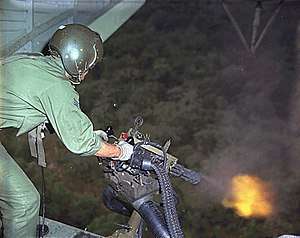
- M60D machine gun - 7.62mm (helicopter mount)[191]
- Minigun - 7.62 mm (aircraft and helicopter mount)[192]
- Colt Mk 12 cannon - 20 mm (aircraft mount)[193]
- M3 cannon - 20 mm (aircraft mount)[194]
- M39 cannon - 20 mm (aircraft mount)[149]
- M61 Vulcan - 20 mm (aircraft mount),[192] M195 was used on AH-1[195]
- M197 Gatling gun - 20 mm (used on AH-1J helicopters)[196]
- M75 grenade launcher - 40 mm (helicopter mount)[197]
- M129 grenade launcher - 40 mm (helicopter mount)[198]
- AIM-4 Falcon[199]
- AIM-7 Sparrow[200]
- AIM-9 Sidewinder[200]
- AGM-12 Bullpup[201]
- AGM-22[202]
- AGM-45 Shrike[203]
- AGM-62 Walleye[204]
- AGM-78 Standard ARM[151]
- AGM-65 Maverick[205]
Chemical weapons
- Agent Orange – While not developed to be used as a weapon against infantry, it was later revealed that it posed health risks.[206]
- Napalm[207]
- CS-1 riot control agent - "Teargas", used in grenades, cluster bomblets or (rarely) shells.[208]
- CN gas - "teargas"[209]
Vehicles
In addition to cargo-carrying and troop transport roles, many of these vehicles were also equipped with weapons and sometimes armor, serving as "gun trucks" for convoy escort duties.[210]
- M274 Truck, Platform, Utility, 1/2 Ton, 4X4 - Commonly called a "Mechanical Mule".[211][212]
- Land Rover (short and long wheelbase) – Australian and New Zealand forces.[213][214]
- CJ-3B and M606 - 1/4 ton jeep[215]
- Willys M38A1 - ¼ ton jeep.
- M151 - ¼ ton jeep.[216][217][218]
- Dodge M37 - 3/4 ton truck.[217]
- Kaiser Jeep M715 - 1¼-ton truck.
- M76 Otter - 1¼-ton amphibious cargo carrier used by USMC.[219]
- M116 Husky - 1¼-ton amphibious cargo carrier tested by USMC.[220]
- M733 Amphibious Personnel Carrier - tested by USMC.[220]
- M35 series 2½-ton 6x6 cargo truck[221]
- M135 2½-ton truck[221]
- M54 5-ton 6x6 truck[222]
- M548 - 6-ton tracked cargo carrier[223][224]
- M520 Goer - 4x4 8-ton cargo truck.[225]
- M123 and M125 10-ton 6x6 trucks[217]
Other vehicles
- Caterpillar D7E bulldozer - used by US Army[226]
- Various graders and bulldozers used by the USMC[227]
- ERDLator[227]
Combat vehicles
Tanks
- M24 Chaffee – light tank; main ARVN tank early in the war,[228] used at least as late as the Tet Offensive.
- M41A3 Walker Bulldog – light tank, replaced the M24 Chaffee as the main ARVN tank from 1965.[229][230]
- M48 Patton medium tank – main tank of the US Army and Marines[231] throughout the war, and also used by ARVN forces from 1971.[232][233]
- M67 "Zippo" – flamethrower variant of the M48 Patton, used by USMC.[231]
- M551 Sheridan – Armored Reconnaissance Airborne Assault Vehicle/Light Tank, used by the US Army from 1969.[234]
- Centurion MK.V Main Battle Tank – used by the Australian Army,[235] with AVLB and ARV variants.[236]
Other armored vehicles
- C15TA Armoured Truck - used by the ARVN early in the war[230]
- LVTP5 (aka AMTRACs) - amphibious tractors/landing craft used by USMC[231][237] and later by RVNMD[233]
- Lynx Scout Car Mk II - used by the ARVN[230]
- M113 - APC (Armored Personnel Carrier)[238][232][239]
- M113 ACAV - Armored Cavalry Assault Vehicle[240]
- M163 Vulcan - self-propelled anti-aircraft tank[241]
- M114 - reconnaissance vehicle[237]
- M132 Armored Flamethrower[242]
- M106 mortar carrier[243]
- M2 Half Track Car
- M3 Scout Car - used by South Vietnamese forces early in the war.[244]
- M3 Half-track - used by South Vietnamese forces early in the war.[244]
- M5 Half-track
- M9 Half-track
- M59 (APC)
- M75 (APC)
- Cadillac Gage V-100 Commando - replaced ARVN M8 armored cars in 1967.[245] Also used by US forces as M706 Commando.[246]
- M8 Greyhound Used by ARVN forces early in the war.[244]
- M56 Scorpion - limited use in 1965-1966[247]
- M50 Ontos - self-propelled 106 mm recoilless rifle carrier used by the USMC until 1969.[231][248]
- M42 Duster - M41 based hull, with a twin 40 mm antiaircraft gun mounted on an open turret[238]
- M728 Combat Engineer Vehicle - modified M60 Patton tank equipped with dozer blade, short-barreled 165mm M135 Demolition Gun, and A-Frame crane.[249]
- M60 AVLB - armored vehicle launched bridge using M60 Patton chassis.[250][251]
- M51 Armored Recovery Vehicle - fielded by US Marines.[231]
- M578 light recovery vehicle[252]
- M88 Recovery Vehicle - armored recovery vehicle based on M48 chassis.[253]
- Wickums armored draisine used by the ARVN.[254]
Naval craft
_slow.jpg)
- LCM-6 and LCM-8 - with several modifications:
- LCMs modified as a river monitors[255]
- Armored Troop Carrier[256]
- Command and Communication Boat (CCB)[256]
- other variants included helipad boats and tankers[256]
- LCVP - Landing craft vehicle personnel, some made by the French Services Techniques des Construction et Armes Navales/France Outremer and known as FOM[256]
- Swift Boat - Patrol Craft Fast (PCF)[257]
- ASPB - assault support patrol boat[255]
- PBR - Patrol Boat River, all-fiberglass boats propelled by twin water jets, used by the US Navy[255]
- Hurricane Aircat - airboat used by ARVN and US Army[258]
Communications
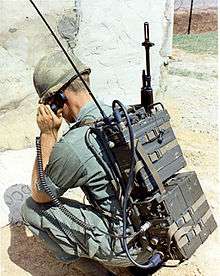
Radios
The geographically dispersed nature of the war challenged existing military communications. From 1965 to the final redeployment of tactical units, numerous communications-electronics systems were introduced in Vietnam to upgrade the quality and quantity of tactical communications and replace obsolete gear:
- AN/PRT-4 and PRR-9 squad radios - replaced the AN/PRC-6.[259]
- AN/PRC-6 and AN/PRC-10 - older short range radios, used for outposts[260][261]
- AN/PRC-25 and 77 - short-range FM radios that replaced the AN/PRC-8-10.[262][263]
- AN/VRC-12 series (VRC-43, VRC-45, VRC-46, VRC-47, VRC-48)[264] - FM radios that replaced the RT-66-67-68/GRC (including AN/GRC 3–8, VRC 7-10, VRC 20–22, and VRQ 1-3 sets).[259]
- AN/GRC-106 - AM radios and teletypewriter that replaced the AN/GRC-19.[265]
- TA-312 and TA-1 field telephones.[264]
Encryption systems
Encryption systems developed by the National Security Agency and used in Vietnam included:[266]
- NESTOR - tactical secure voice system, including the TSEC/KY-8, 28 and 38 was used with the PRC-77 and VRC-12
- KW-26 - protected higher level teletype traffic
- KW-37 - protected the U.S. Navy fleet broadcast
- KL-7 - provided offline security
- A number of paper encryption and authentication products, including one time pads and the KAL-55B Tactical Authentication System[267]
Weapons of the PAVN/VC
The PAVN and the Southern communist guerrillas, the Viet Cong (VC) as they were commonly referred to during the war, largely used standard Warsaw Pact weapons. Weapons used by the PAVN also included Chinese Communist variants, which were referred to as CHICOM's by the US military. Captured weapons were also widely used; almost every small arm used by SEATO may have seen limited enemy use. During the early 1950s, US equipment captured in Korea was also sent to the Viet Minh.
Small arms
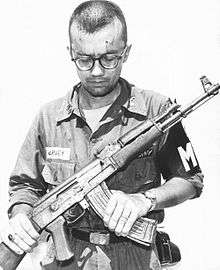
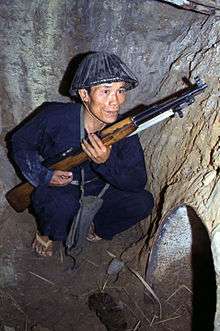
Hand combat weapons

Handguns and revolvers
- Makarov PM (and Chinese Type 59)[270][271]
- Mauser C96 – Locally produced copies were used alongside Chinese copies and German variants supplied by the Soviets.[272]
- M1911 pistol[270]
- M1935A pistol[270]
- SA vz. 61 - automatic pistol[273]
- Tokarev TT-33 - Standard pistol, including Chinese Type 51 and Type 54 copies including Zastava M57 [271]
- Walther P38 – Captured by the Soviets during World War II and provided to the VPA and the NLF as military aid[272]
- Home-made pistols, such as copies of the M1911 or of the Mauser C96 (Cao Dai 763) or crude single-shot guns, were also used by the Viet Cong early in the war.[272][274]
Automatic and semi-automatic rifles
- SKS (Chinese Type 56) semi-automatic carbine[275][276]
- AK-47 – from the Soviet Union, Warsaw Pact countries, China and North Korea[275]
- AKM - from the Soviet Union, common modernized variant of the AK-47[278][279]
- PM md. 63/65 - Romanian variant of AKM[280]
- AMD-65 - Very limited use from Hungary[281]
- M1/M2 carbines - common and popular captured semi-automatic rifles[282][276]
- vz. 52 rifle semi-automatic rifle, very rarely used[275]
- Vz. 58 assault rifle[275]
- Sturmgewehr 44 Limited[272]
- Type 63 assault rifle - Limited use, received during the 1970s[283]
- M14, M16A1 - captured from US and South Vietnamese forces.[270][275]
- M1 Garand - captured semi-automatic rifle[282]
- MAS-49 rifle – captured French rifle from First Indochina War
Bolt-action rifles/marksman rifles
- Mosin–Nagant – Bolt-action rifles and carbines from the Soviet Union and China (especially M44).[284][285]
- Mauser Kar98k – Bolt-action rifle (captured from the French during the First Indochina War and also provided by the Soviets as military aid).[272]
- Chiang Kai-shek rifle - Used by recruits and militias[286]
- MAS-36 rifle [271]
- Lee–Enfield - Used by the Viet Cong[287]
- Arisaka rifles - used by Viet Cong early in the war.[288]
- Lebel rifle – Used in earlier stages of the Vietnam War.[270][271]
- vz. 24 – Used by Viet Cong Forces.[289]
- SVD Dragunov - Soviet semi-automatic sniper rifle in limited use[290]
- M1903 Springfield - Used by Viet Cong forces[291]
- M1917 Enfield - Used by Viet Cong forces[292]
- Remington Model 10 – pump-action shotgun used by the Viet Cong[293]
- Older or rarer rifles where often modified by the Viet Cong early in the war: Gras mle 1874 carbines were rechambered to .410 bore while Destroyer carbines were modified to accept the magazine of the Walther P38.[288]
- Home-made rifles, often spring-action rifles made to look like a M1 Garand or a M1 Carbine, were also used by the Viet Cong.[274]
Submachine guns
- K-50M submachine gun (Vietnamese edition, based on Chinese version of Russian PPSh-41, under licence)[294]
- MAT-49 submachine gun – Captured during the French-Indochina War. Many were converted from 9x19mm to 7.62x25 Tokarev[30]
- PPSh-41 submachine gun (both Soviet, North Korean and Chinese versions)[295][277]
- PPS-43 submachine gun (both Soviet and Chinese versions)[296]
- M3 submachine gun Limited use [282]
- Thompson submachine gun[282] - including Vietnamese copies[228]
- MP 40[297]
- MAS-38 submachine gun – Captured from the French in the Indochina War.[298]
- PM-63 submachine gun - Used by tank crews
- Vietnamese home-made submachine guns, inspired by the Sten or the Thompson, were used by the Viet Cong early in the war.[274][288]
Machine guns
- Bren light machine gun, used by Viet Cong[272]
- Degtyarev DP (DPM and RP-46 variants and Chinese Type 53 and Type 58 copies)[299]
- DShK heavy machine gun (including Chinese Type 54)[299][300]
- FM-24/29 - used by Viet Cong Forces[301]
- KPV heavy machine gun[302]
- M1918 Browning Automatic Rifle[303]
- M1917 Browning machine gun - at least 1 used by the Viet Cong[304]
- M1919 Browning machine gun - captured from ARVN/US forces[299]
- M60 machine gun - captured from ARVN/US forces[299]
- M2 Browning[299] - captured from ARVN/US forces
- MG 34 - captured by the Soviets during World War II and provided to the VPA and the NLF as military aid[272]
- MG 42 - captured by the Soviets during World War II and provided to the VPA and the NLF as military aid
- FG 42 - Limited use, captured by the Soviets during World War II and supplied in the 1950s[272]
- Maxim machine-gun M1910[296]
- PK Very limited use general-purpose machine gun from Soviet Union[305]
- RPD light machine gun (and Chinese Type 56 and North Korean Type 62 copies) - first used in 1964[306][307][277]
- RPK light machine gun of Soviet design[308]
- SG-43/SGM medium machine guns including Type 53 and Type 57 Chinese copies of these guns[299]
- Type 11 light machine gun[309]
- Type 24 machine gun (Chinese-made MG-08) - used by the Viet Cong Forces[310]
- Type 67 machine gun[311]
- Type 92 heavy machine gun[312]
- Type 99 light machine gun[313][310]
- Uk vz. 59 general-purpose machine gun[314]
- ZB vz. 26 light machine gun (included Chinese copies)[315][310]
- ZB vz.30 light machine gun from Czechoslovakia
Grenades and mines
- Molotov cocktail
- Home-made grenades[316]
- F1 grenade (Chinese Type 1)[299][317]
- M29 grenade - captured[318]
- M79 grenade launcher - captured from US or ARVN forces[319]
- M203 grenade launcher - captured from US or ARVN forces
- Model 1914 grenade
- RG-42 grenade (Chinese Type 42)[70][299]
- RGD-1 and RGD-2 smoke grenades[70]
- RGD-5 grenade (Chinese Type 59)[299]
- RGD-33 stick Grenade
- RKG-3 anti-tank grenade (Chinese Type 3)[70][320]
- RPG-40 Anti-Tank Hand Grenade
- RPG-43 HEAT (High Explosive Anti-Tank) Hand Grenade
- RPG-6
- Type 4 grenade
- Type 10 grenade
- Type 67 and RGD-33 stick grenades[69][70]
- Type 64 rifle grenade - fired from AT-44 grenade launchers, fitted to Mosin-Nagant carbines[285]
- Type 91 grenade
- Type 97 grenade
- Type 99 grenade
- Type 10 grenade discharger
- Type 89 grenade discharger[268]
- Lunge mine
Rocket launchers, recoilless rifles, anti-tank rifles and lightweight guided missiles
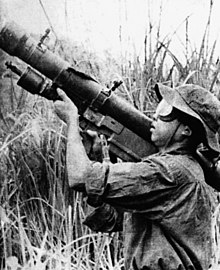
- Recoilless rifles were known as DKZ (Đại-bác Không Giật).[322]
- RPG-2 recoilless rocket launcher (both Soviet, Chinese and locally produced B-40 and B-50 variants used)[323]
- RPG-7 recoilless rocket launcher[324]
- Type 51 (Chinese copy of the M20 Super Bazooka) - used by Viet Cong as late as 1964[89]
- B-10 recoilless rifle[325][300]
- B-11 recoilless rifle[325]
- SPG-9 73 mm recoilless rifle[282][300]
- M18 recoilless rifle (and Chinese Type 36 copy) and captured from US or ARVN forces[300][326]
- M20 recoilless rifle (and Chinese Type 52 and Type 56 copies) and captured from US or ARVN forces[300][327]
- PTRD Limited use by the Viet Cong Forces.[272]
- 9K32 Strela-2 (SA-7) anti-aircraft weapon[328]
- 9M14 Malyutka (AT-3 Sagger)[329]
Mortars
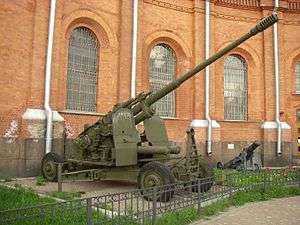
- Brandt Mle 1935 - 60mm mortar[282]
- M2 mortar (including Chinese Type 31 and Type 63 copies) - 60mm mortars[282]
- M19 mortar - 60mm mortar[282]
- M1 mortar - 81mm[282]
- M29 mortar - 81mm[282]
- Brandt Mle 27/31 - 81mm mortar[282]
- Type 97 81mm mortar
- 82-PM-37 (including Chinese Type 53 copy)- 82mm mortar[282]
- 82-PM-41 - 82mm mortar.
- Type 67 mortar - 82mm mortar[99]
- Type 94 90mm mortar
- Type 97 90 mm mortar
- M1938 107mm mortar
- 120-PM-43 mortar[282]
- Type 97 150 mm mortar
- M1943 160mm mortar (including Chinese Type 55 copy)[282]
Field artillery rocket launchers
Field artillery rockets were often fired from improvised launchers, sometines a tube fixed with bamboo.[89]
- 102mm 102A3 rockets[330]
- 107mm Type 63 MRL - used with single-tube or 12-tubes launchers[330][331]
- single-tube 122mm 9M22M rocket taken from BM-21 Grad MRL[330][331]
- single-tube 140mm M14-OF rocket taken from BM-14 MRL[330]
Field guns and howitzers
- 57 mm anti-tank gun M1943 (ZiS-2)[332]
- 70 mm Type 92 battalion gun[333][296]
- Type 41 75 mm mountain gun, supplied by China[296]
- 7.5 cm Pak 40[334]
- 75mm M116 pack howitzer[335], supplied by China
- 76 mm divisional gun M1942 (ZiS-3) (and Chinese Type 54)[335][336][296]
- 85 mm divisional gun D-44[335]
- 100 mm field gun M1944 (BS-3)[335][336]
- Type 91 10 cm howitzer, supplied by China[296]
- M101 howitzer[335]
- 122 mm gun M1931/37 (A-19)[335][336]
- 122 mm howitzer M1938 (M-30) [335][336]
- D-74 122 mm Field Gun[337][336]
- 130 mm towed field gun M1954 (M-46)[335][336]
- 152 mm howitzer-gun M1937 (ML-20)[335]
- 152 mm howitzer M1943 (D-1)
- 152 mm towed gun-howitzer M1955 (D-20)[328]
- M114 155 mm howitzer[338]
Anti-aircraft weapons
- ZPU-1/2/4 single, double and quad 14.5 mm anti-aircraft machine guns[339]
- ZU-23 twin 23 mm anti-aircraft cannon[340]
- M1939 37 mm anti-aircraft gun (and Chinese Type 55)[341][342]
- S-60 57 mm anti-aircraft gun[343][341]
- 85mm air defense gun M1944[340]
- 100 mm air defense gun KS-19[340]
- 8.8 cm Flak 18/36/37/41[344]
- S-75 Dvina Soviet high-altitude air defence system[345][346]
- S-125 Neva Soviet high-altitude air defence system[347]
Aircraft
- Aero Ae-45 trainer aircraft[348]
- Aero L-29 Delfín trainer aircraft[349]
- An-2 utility aircraft[350]
- Cessna A-37 Dragonfly attack aircraft - limited use of captured or defected[351]
- Ilyushin Il-12 transport aircraft[352]
- Ilyushin Il-14 transport aircraft[352]
- Ilyushin Il-28 jet bomber[353]
- Lisunov Li-2 transport aircraft[352]
- Mikoyan-Gurevich MiG-15 (and Chinese F-4) jet trainer[354]
- MiG-17 (and Chinese F-5) jet fighter[355][356]
- MiG-19 (and Chinese F-6) jet fighter[357]
- MiG-21 jet fighter[358]
- North American T-28 Trojan - 1 ex-Laotian used in 1964[359]
- Yakovlev Yak-18 trainer aircraft[360]
- Zlín Z 26 trainer aircraft[360]
Aircraft weapons
Tanks
- M24 Chaffee - light tank, captured from the French and used for training early in the war[298]
- M41 Walker Bulldog – light tank, captured from the ARVN.[367][368]
- M48 Patton - captured from the ARVN.[369]
- PT-76 amphibious tank[250][370][371]
- SU-76 self-propelled gun[250][371]
- SU-100 self-propelled guns in limited numbers.[372]
- SU-122 self-propelled gun in limited numbers[250][372]
- T-34-85 medium tank, from 1959[250][373]
- T-54 main battle tanks,[374][371] used from 1965[334]
- Type 59 main battle tanks[374]
- Type 62 light tank
- Type 63 anti-aircraft self-propelled systems
- Type 63 amphibious tank[375]
- ZSU-57-2 anti-aircraft self-propelled systems[376]
- ZSU-23-4 anti-aircraft self-propelled systems[374]
Other armored vehicles
Support vehicles
- AT-L light artillery tractor[343]
- AT-S and ATS-59 medium artillery tractors[343][382]
- Beijing BJ212[369]
- Dnepr M-72
- GAZ-AA
- GAZ-MM
- GAZ 46 light amphibious car[383]
- GAZ-51 truck (and Chinese copy)[384]
- GAZ-63 truck[385][386]
- GAZ-64
- GAZ-67
- GAZ-69[380]
- IFA W 50[369]
- KrAZ-255 heavy truck[387]
- Mazur D-350 artillery tractor[388]
- MAZ-502 truck[386]
- M35 truck series (captured)[382]
- M54 truck series (captured)[382]
- M151 jeep (captured)[369]
- PMZ-A-750
- ZIS-150 truck (and Chinese CA-10)[382]
- Ural ZIS-355M truck[386]
- Ural-375
- ZIL-130 truck[343]
- ZIL-151 truck[389]
- ZIL-157 and ZIL-157K trucks (and Chinese CA-30)[356][390]
- ZiS-485 amphibious vehicle[391][382]
Naval craft
- Swatow-class gunboats[392]
- P4 and P6 torpedo boats[392]
- Countless civilian-type sampans - mainly used for smuggling supplies and weapons[393]
See also
- NLF and PAVN strategy, organization and structure
- NLF and PAVN logistics and equipment
- NLF and PAVN battle tactics
- Weapons of the Laotian Civil War
- Weapons of the Cambodian Civil War
References
Citations and notes
- Sheehan 2009, p. 813.3.
- Sheehan 2009, p. 187.2.
- Sheehan 2009, p. 994.1.
- Sheehan 2009, p. 814.4.
- Sheehan 2009, p. 1883.5.
- Seals, Bob (23 September 2008). "Chinese Support for North Vietnam during the Vietnam War: The Decisive Edge". Military History Online.
- Parray, Albert (June 1967). "Soviet aid to Vietnam" (PDF). Military Review. Archived from the original (PDF) on 28 April 2011.
- Miller, Robert; Wainstock, Dennis D. (2013). Indochina and Vietnam: The Thirty-five Year War, 1940–1975. Enigma Books. pp. 101–02. ISBN 978-1936274666.
- "North Vietnam's Master Plan". HistoryNet. Retrieved 2018-06-01.
- Warren, James A. (2013). Giáp: The General Who Defeated America in Vietnam. St. Martin's Press. ISBN 978-1137098917.
- Bart Hagerman, USA Airborne: 50th Anniversary, Turner Publishing Company, p.237
- Lieutenant General John J. Tolson (1989). Vietnam Studies: Airmobility 1961–71. Department of the Army. US Government Printing Office. CMH Pub 90-4.
- "ITN news reel". Youtube. 16 July 2007. Retrieved 29 April 2011.
- Smith, George W. (1999). The siege at Hue. Lynne Reinner Publishers. pp. 142–143.
- Dwayne A. Day, Helicopters at War Archived 2010-04-14 at the Wayback Machine U.S. Centennial of Flight Commission
- Biggs, David. "Opinion | Vietnam: The Chemical War". Retrieved 2018-06-20.
- Rottman 2017, p. 39.
- "The M1 Garand in Vietnam". wwiiafterwwii.wordpress.com. 17 January 2019.
- Rottman 2006, p. 48.
- Russell 1983, p. 33.
- Gilbert 2006, p. 66.
- Russell 1983, p. 37.
- "Archery in Vietnam".
- "Montagnard Crossbow, Vietnam". awm.gov.au. Australian War Memorial. Retrieved 4 February 2019.
- Ezell 1988, p. 155.
- Rottman 2010, p. 45.
- Rottman 2017, p. 11.
- Rottman 2011b, p. 40.
- Rottman 2012, p. 22.
- Dockery, Kevin (December 2004). Weapons of the Navy SEALs. New York City: Berkley Publishing Group. p. 382. ISBN 0-425-19834-0.
- Rottman 2002, p. 43.
- Rottman 2002, p. 21.
- Rottman 2010, p. 47.
- Rottman 2008, p. 56.
- Tucker 2011, p. 975.
- Ezell 1988, pp. 51-52.
- Russell 1983, p. 34.
- Tucker 2011, p. 973.
- "U.S. M16: A Half-Century of America's Combat Rifle". www.americanrifleman.org.
- Smith 1969, p. 720.
- Rottman 2010, p. 18.
- Rottman 2011b, p. 38.
- Rottman 2007b, p. 48.
- Tucker 2011, p. 974.
- Pegler, Martin (20 Nov 2010). Sniper Rifles: From the 19th to the 21st Century. Weapon 6. Osprey Publishing. pp. 56–59. ISBN 9781849083980.
- Thompson, Leroy (2012). The M1 Garand. Oxford: Osprey. pp. 67–68. ISBN 9781849086219.CS1 maint: ref=harv (link)
- Tucker 2011, pp. 974-975.
- Gander, Jerry (2002). Jane's Infantry Weapons 2002–2003. Jane's Information Group. pp. 214, 899–906. ISBN 0-7106-2434-4.
- Tucker 2011, p. 1076.
- Rottman 2011a, p. 20.
- Moss, Matthew (29 Nov 2018). The Sterling Submachine Gun. Weapon 65. Osprey Publishing. p. 65. ISBN 9781472828088.CS1 maint: ref=harv (link)
- Rottman 2002, p. 41.
- Dye & Laemlein 2015, p. 22.
- Thompson 2013, p. 19.
- Dye & Laemlein 2015, pp. 33-35&38.
- Rottman 2002, p. 42.
- Dye & Laemlein 2015, pp. 34-37.
- Thompson 2013, p. 65.
- Thompson 2013, pp. 25-26.
- Dye & Laemlein 2015, p. 39.
- Thompson 2013, p. 20.
- Canfield, Bruce N. (March 2002). "Combat Shotguns of the Vietnam War". American Rifleman. pp. 44–47&92–95.
- Higgins 2015, p. 24.
- Thompson 2013, pp. 20-21.
- Thompson 2013, p. 7.
- Ezell 1988, p. 60.
- Rottman 2011c, p. 38.
- Rottman & Spaulding 2002, p. 4.
- Rottman 2015, p. 56.
- Tucker 2011, p. 451.
- Rottman 2006, p. 45.
- Rottman 2015, p. 26.
- Russell 1983, p. 9.
- Rottman 2015, pp. 56-57.
- Rottman 2015, p. 28.
- Russell 1983, p. 9,36.
- "Smoke Grenades". MACV-SOG – Living History.
- Russell 1983, p. 30.
- Rottman 2015, p. 29.
- Rottman 2009, p. 43.
- Rottman 2015, p. 18.
- Rottman 2005, p. 17.
- Rottman 2011b, p. 43.
- Tucker 2011, p. 430.
- Stoner, Bob. "Ordnance Notes". warboats.org.
- Ezell 1988, pp. 106-107.
- Rottman 2010, pp. 7, 34.
- Rottman, Gordon L. (2012). The Bazooka. Osprey Publishing. pp. 69–70, 75–76. ISBN 978-1849088015.CS1 maint: ref=harv (link)
- Tucker 2011, p. 987.
- XM191 Multishot Portable Flame Weapon (PDF) (Report). Army Concept Team in Vietnam. 1970. pp. 2–3.
- McKenna 2011, p. 91.
- Rottman 2012, p. 24.
- Gilbert 2006, p. 67.
- Rottman 2010, p. 35.
- Rottman 2010, p. 7.
- Ezell 1988, p. 143.
- Rottman 2011a, p. 22.
- Rottman 2010, p. 15.
- Higgins 2015, p. 78.
- Rottman 2010, p. 9.
- Rottman 2007a, p. 56.
- Rottman 2005, p. 44.
- Rottman 2010, p. 32.
- Gilbert 2006, pp. 68-69.
- Tucker 2011, p. 71.
- Rottman 2011c, p. 36.
- Robinson 1983, p. 136.
- Higgins 2015, p. 28.
- Foster 2007, pp. 8, 25.
- Foster 2007, pp. 25, 28.
- Green 1996, p. 71.
- Foster 2007, p. 14.
- Green 1996, p. 72.
- Dunstan 1985, p. 38.
- "L5 105mm Pack Howitzer". 5rar.asn.au.
- "Gunners' Day Feature: Italian L5 105mm Pack Howitzer". armymuseum.co.nz. National Army Museum. 26 May 2017.
- Use of Hawk Missiles in Vietnam. // Department of Defense appropriations for 1970, pt. 5, pp. 377-378.
- Tucker 2011, p. 72.
- Tucker 2011, pp. 72-73.
- Tucker 2011, p. 73.
- Nalty, Watson & Neufeld 1981, pp. 44-47.
- Nalty, Watson & Neufeld 1981, pp. 56-59.
- Nalty, Watson & Neufeld 1981, pp. 108-111.
- Nalty, Watson & Neufeld 1981, pp. 68-69.
- Nalty, Watson & Neufeld 1981, pp. 156-157.
- Nalty, Watson & Neufeld 1981, pp. 48-49.
- Nalty, Watson & Neufeld 1981, pp. 36-37.
- Nalty, Watson & Neufeld 1981, pp. 50-53.
- Nalty, Watson & Neufeld 1981, pp. 60-61.
- Nalty, Watson & Neufeld 1981, pp. 84-89.
- Nalty 2001, p. 412.
- Nalty, Watson & Neufeld 1981, pp. 22-27.
- Nalty, Watson & Neufeld 1981, pp. 100-105.
- Nalty, Watson & Neufeld 1981, pp. 82-83.
- Nalty, Watson & Neufeld 1981, pp. 42-43.
- Tucker 2011, p. 20.
- Nalty, Watson & Neufeld 1981, pp. 92-93.
- Nalty, Watson & Neufeld 1981, pp. 62-65.
- Nalty, Watson & Neufeld 1981, pp. 56-57.
- Nalty, Watson & Neufeld 1981, pp. 54-55.
- Nalty, Watson & Neufeld 1981, pp. 90-91.
- Tucker 2011, p. 27.
- Nalty, Watson & Neufeld 1981, p. 12.
- Nalty, Watson & Neufeld 1981, pp. 112-117.
- Nalty, Watson & Neufeld 1981, pp. 136-139.
- "F8F Bearcat post-WWII service". wwiiafterwwii.wordpress.com. 22 July 2015.
- Nalty, Watson & Neufeld 1981, pp. 158-159.
- Tobin, Thomas (1978). USAF Southeast Asia Monograph Series Volume IV Monograph 6: Last Flight from Saigon (PDF). US Government Printing Office. pp. 98, 123. ISBN 978-1-4102-0571-1.
- Nalty, Watson & Neufeld 1981, pp. 126-129.
- Tucker 2011, p. 18.
- Nalty, Watson & Neufeld 1981, pp. 140-143.
- Nalty, Watson & Neufeld 1981, pp. 66-67.
- Nalty, Watson & Neufeld 1981, pp. 72-73.
- Tucker 2011, p. 474.
- Nalty, Watson & Neufeld 1981, pp. 28-29.
- Nalty, Watson & Neufeld 1981, pp. 38-39.
- Nalty, Watson & Neufeld 1981, pp. 40-41.
- Nalty, Watson & Neufeld 1981, pp. 74-75.
- Nalty, Watson & Neufeld 1981, pp. 134-135.
- Nalty, Watson & Neufeld 1981, pp. 94-95.
- Tucker 2011, p. 22.
- Nalty, Watson & Neufeld 1981, pp. 106-107.
- Nalty, Watson & Neufeld 1981, pp. 130-131.
- Tucker 2011, p. 340.
- Nalty, Watson & Neufeld 1981, pp. 118-119.
- Nalty, Watson & Neufeld 1981, p. 11.
- Nalty, Watson & Neufeld 1981, pp. 96-97.
- Nalty, Watson & Neufeld 1981, pp. 132-133.
- Nalty 2001, p. 161.
- Robinson 1983, p. 61.
- Nalty, Watson & Neufeld 1981, pp. 98-99.
- Nalty 2001, p. 148.
- Nalty, Watson & Neufeld 1981, p. 15.
- Nalty 2001, p. 434.
- Nalty, Watson & Neufeld 1981, pp. 100-101.
- Tucker 2011, p. 469.
- Nalty, Watson & Neufeld 1981, pp. 18-21.
- Rottman 2011b, p. 53.
- Tucker 2011, p. 472.
- Nalty, Watson & Neufeld 1981, pp. 80-81.
- Nalty, Watson & Neufeld 1981, pp. 152-155.
- Tucker 2011, p. 471.
- Nalty, Watson & Neufeld 1981, pp. 76-77.
- Nalty, Watson & Neufeld 1981, pp. 146-147.
- Nalty, Watson & Neufeld 1981, pp. 78-79.
- Nalty, Watson & Neufeld 1981, pp. 30-31.
- Tucker 2011, p. 470.
- Nalty, Watson & Neufeld 1981, pp. 32-35.
- Nalty, Watson & Neufeld 1981, pp. 148-151.
- Nalty, Watson & Neufeld 1981, pp. 144-145.
- Tucker 2011, p. 695.
- Tucker 2011, p. 696.
- Nalty, Watson & Neufeld 1981, pp. 108, 156 & 158.
- Burgess, Rick; Rausa, Zip (10 Mar 2009). US Navy A-1 Skyraider Units of the Vietnam War. Combat Aircraft 77. Osprey Publishing. p. 90. ISBN 9781846034107.
- Bernstein 2003, p. 43.
- Bishop, Chris (10 Aug 2006). Huey Cobra Gunships. New Vanguard 125. Osprey Publishing. pp. 12–13, 33. ISBN 9781841769844.
- Robinson 1983, p. 55.
- Bernstein 2003, p. 26.
- Tucker 2011, p. 34.
- Tucker 2011, pp. 34-35.
- Tucker 2011, p. 35.
- Tucker 2011, p. 36.
- Tucker 2011, pp. 35-36.
- Tucker 2011, p. 930.
- Robinson 1983, p. 159.
- Tucker 2011, p. 935.
- Tucker 2011, pp. 788-790.
- Rottman 2012, p. 12.
- Rottman 2006, p. 49.
- Rottman 2011c, pp. 5-6.
- Higgins 2015, p. 30.
- Mesko 1982, p. 24.
- "Rear view of a Land Rover used by the Australian army in South Vietnam". awm.gov.au. Australian War Memorial. 1971. Retrieved 16 January 2019.
- "Land Rover at Bien Hoa". vietnamwar.govt.nz. Ministry for Culture and Heritage. 28 April 2011. Retrieved 16 January 2019.
- Redmond, Derek (September 2015). "Jeeps in Vietnam, 1961-1975: CJ-3B, M606 and J4". cj3b.info.
- Rottman 2008, p. 37.
- Rottman 2011c, p. 10.
- Mesko 1982, p. 67.
- Mesko 1982, p. 21.
- Mesko 1982, p. 28.
- Rottman 2011c, p. 30.
- Rottman 2011c, pp. 30-31.
- Dunstan 1985, p. 34.
- Rottman 2008, p. 32.
- Rottman & Spaulding 2002, p. 49.
- Rottman 2008, p. 59.
- Gilbert 2006, p. 36.
- Ezell 1988, p. 59.
- Rottman 2010, p. 38.
- Grandolini 1998, p. 4.
- Dunstan 1985, p. 16.
- Green 1996, p. 4.
- Grandolini 1998, p. 7.
- Dunstan 1985, p. 26.
- Dunstan 1985, pp. 39-40.
- Green 1996, p. 54.
- Tucker 2011, p. 62.
- Dunstan 1985, p. 23.
- Tucker 2011, pp. 61-62.
- Dunstan 1985, p. 19.
- Green 1996, p. 50.
- Rottman 2010, p. 37.
- Dunstan 1985, p. 12.
- Ezell 1988, p. 54.
- Dunstan 1985, p. 13.
- Dunstan 1985, p. 32.
- Estes, Kenneth W (2016). M50 Ontos and M56 Scorpion 1956–70: US Tank Destroyers of the Vietnam War. New Vanguard 240. Osprey Publishing. p. 43. ISBN 9781472814739.CS1 maint: ref=harv (link)
- Higgins 2015, p. 36.
- Dunstan 1985, p. 39.
- Tucker 2011, p. 1088.
- Green 1996, p. 22-23.
- Grandolini 1998, p. 19.
- Green 1996, pp. 19-21.
- Mesko 1982, p. 15.
- Tucker 2011, p. 979.
- Tucker 2011, p. 980.
- Tucker 2011, pp. 1081-1083.
- Rottman 2007b, p. 50.
- Myer 1982, p. 81.
- Rottman 2011a, p. 42.
- Myer 1982, p. 10.
- Myer 1982, p. 79.
- Rottman 2011a, p. 41.
- Rottman 2007a, p. 63.
- Myer 1982, p. 82.
- A History of U.S. Communications Security (The David G. Boak Lectures) (PDF). National Security Agency (NSA). Volume I (1973), Volume II (1981), partially released 2008, additional portions declassified October 14, 2015.
- http://www.jproc.ca/crypto/kal55.html
- "Mukden Arsenal after WWII". wwiiafterwwii.wordpress.com. April 3, 2017.
- Robinson 1983, p. 12.
- Rottman 2007a, p. 25.
- Rottman 2009, p. 33.
- "WWII German weapons during the Vietnam War". wwiiafterwwii.wordpress.com. 10 July 2015. Retrieved 8 December 2017.
- "7,65mm samopal vz.61 Škorpion".
- Weaver, W. Darrin (22 October 2015). "Viet Cong Weaponry: 14 Small Arms From the Vietnam War". Military Surplus Magazine.
- Rottman 2009, p. 28.
- Rottman 2007a, p. 23.
- "North Korean Small Arms". Small Arms Defense Journal. Retrieved 27 July 2017.
- Rottman 2011b, p. 37.
- Walter J. Boyne (2003). Operation Iraqi Freedom: What Went Right, What Went Wrong, and Why. p. 110. ISBN 978-0-7653-1038-5.
- "Was the K63 / Type 63a / Type 68 used during the Vietnam War".
- "Hungarian AMD-65 carbine". iwm.org.uk. Imperial War Museum. Retrieved 19 February 2019.
- Rottman 2009, p. 32.
- Tucker 2011, p. 976.
- Rottman 2007a, p. 22.
- Rottman 2009, pp. 28-29.
- Rottman 2009, p. 25.
- "Ragtag Viet Cong Become A 20th Century Army". Madera Tribune. 76 (190). 9 February 1968 – via California Digital Newspaper Collection.
- Truby, J. David (29 November 2013). "Early VC Small Arms". SmallArmsReview.com.
- Ball, Robert W. D. (2011). Mauser Military Rifles of the World. Iola: Gun Digest Books. pp. 116–118. ISBN 9781440228926.
- Ezell 1988, p. 134.
- Rottman 2009, p. 21.
- "Model 1917 Enfield Rifle : North Vietnamese Military Forces". awm.gov.au. Australian War Memorial.
- Dye & Laemlein 2015, p. 34.
- Ezell 1988, p. 44.
- Rottman 2009, pp. 29-30.
- Robinson 1983, p. 92.
- Ezell 1988, p. 42.
- Robinson 1983, p. 91.
- Rottman 2009, p. 31.
- Rottman 2007a, p. 26.
- Ezell 1988, pp. 44-45.
- Robinson 1983, p. 94.
- Hodges, Robert R.; Hodges, Robert R. Jr. (20 Apr 2012). The Browning Automatic Rifle. Weapon 15. Osprey Publishing. p. 67. ISBN 9781849087612.CS1 maint: ref=harv (link)
- Dye & Laemlein 2015, p. 210.
- Schuster, Carl O. (December 2016). "Arsenal | The NVA's 'Quick Change' Machine Gun". Vietnam Magazine. Retrieved 21 December 2016 – via HistoryNet.
- Ezell 1988, pp. 88-89.
- Rottman 2009, p. 29.
- Dye & Laemlein 2015, p. 183.
- "Type 11 Light Machine Gun". awm.gov.au. Australian War Memorial. Retrieved 4 February 2019.
- Smith 1969, p. 719.
- James H. Willbanks (2004). Machine Guns: An Illustrated History of Their Impact. ABC-CLIO. p. 134. ISBN 978-1-85109-480-6.
- "Type 92 Heavy Machine Gun". awm.gov.au. Australian War Memorial. Retrieved 4 February 2019.
- Ezell 1988, p. 47.
- Scarlata, Paul (December 15, 2016). "Eastern Bloc Firestorm: The Czech UK vz. 59 Machine Gun". Military Surplus Magazine.
- Rottman 2009, p. 27.
- "Grenade Improvised (Viet Cong)". iwm.org.uk. Imperial War Museum.
- Rottman 2015, p. 32.
- Conboy 1992, pp. 22-23.
- Rottman 2007a, pp. 23-24.
- Rottman 2015, p. 60.
- McNab, Chris (20 Aug 2015). The Flamethrower. Weapon 41. Osprey Publishing. pp. 70–72. ISBN 9781472809025.
- Rottman 2006, p. 12.
- Rottman, Gordon L. (2010). The Rocket Propelled Grenade. Weapon 2. Osprey Publishing. pp. 19, 40–41. ISBN 978-1-84908-153-5.
- Ezell 1988, p. 144.
- Ezell 1988, pp. 142-143.
- Ezell 1988, pp. 141-142.
- Ezell 1988, p. 142.
- Ezell 1988, p. 153.
- Ezell 1988, pp. 146-147.
- Tucker 2011, p. 988.
- Ott 1975, p. 12.
- Grandolini 1998, p. 18.
- Ott 1975, p. 13.
- Grandolini 1998, p. 17.
- Tucker 2011, p. 1251.
- Ott 1975, p. 227.
- Rottman 2005, p. 59.
- Grandolini 1998, p. 54.
- Smith 1969, p. 718.
- Tucker 2011, p. 52.
- Robinson 1983, p. 100.
- Rottman 2005, p. 61.
- Grandolini 1998, p. 41.
- Schuster, Carl O. (2016-07-27). "The Rise of North Vietnam's Air Defenses". HistoryNet. Retrieved 2020-01-06.
- Tucker 2011, pp. 1079-1080.
- Toperczer 2001, p. 22.
- Toperczer 2001, p. 23.
- Toperczer 2001, pp. 10-11.
- Toperczer 2001, p. 19.
- Conboy 1992, p. 45.
- Conboy 1992, p. 25.
- Conboy 1992, p. 48.
- Conboy 1992, p. 49.
- Robinson 1983, p. 104.
- Nalty, Watson & Neufeld 1981, pp. 120-121.
- Toperczer 2001, p. 34.
- Nalty, Watson & Neufeld 1981, pp. 122-123.
- Nalty, Watson & Neufeld 1981, pp. 122-125.
- Toperczer 2001, pp. 8-9.
- Toperczer 2001, p. 11.
- Nalty, Watson & Neufeld 1981, p. 124.
- Nalty, Watson & Neufeld 1981, p. 122.
- Toperczer 2001, p. 36.
- Nalty, Watson & Neufeld 1981, p. 120.
- Toperczer, István (25 Dec 2001). MiG-21 Units of the Vietnam War. Combat Aircraft 29. Osprey Publishing. pp. 93–94. ISBN 9781841762630.
- Tucker 2011, p. 473.
- McKenna 2011, p. 260.
- Grandolini 1998, p. 10.
- Grandolini, Albert (February 2013). "Objectif Saigon ! 2e partie : Surprise sur les Hauts Plateaux". Batailles & Blindés (in French). No. 53. Caraktère. pp. 8–21. ISSN 1765-0828.
- McKenna 2011, p. 61.
- Grandolini 1998, p. 8.
- Grandolini 1998, pp. 10, 65.
- Grandolini 1998, p. 37.
- Dunstan 1985, p. 40.
- Grandolini 1998, p. 35.
- Dunstan 1985, p. 35.
- Grandolini 1998, pp. 24-25.
- Grandolini 1998, p. 38.
- Grandolini 1998, p. 11.
- Grandolini 1998, p. 16.
- Grandolini 1998, p. 40.
- Grandolini, Albert (April 2013). "Objectif Saigon ! 3e partie : La chute du régime sud-vietnamien". Batailles & Blindés (in French). No. 54. Caraktère. pp. 66–79. ISSN 1765-0828.
- Grandolini 1998, p. 50.
- Rottman 2011b, p. 10.
- Grandolini 1998, p. 25.
- Sherwood, John Darrell (May 2004). Afterburner: Naval Aviators and the Vietnam War. New York University Press. p. 34. ISBN 9780814798423.
- Grandolini 1998, p. 48.
- Grandolini 1998, pp. 47-48.
- Toperczer 2001, p. 28.
- Grandolini, Albert (October 2012). "Objectif Saigon ! 1re partie : Le renouveau nord-vietnamien". Batailles & Blindés (in French). No. 51. Caraktère. pp. 66–79. ISSN 1765-0828.
- Grandolini 1998, p. 49.
- Tucker 2011, p. 1321.
- Tucker 2011, p. 705.
Bibliography
- Bernstein, Jonathan (25 Sep 2003). US Army AH-1 Cobra Units in Vietnam. Combat Aircraft 41. Osprey Publishing. ISBN 9781841766065.CS1 maint: ref=harv (link)
- Conboy, Kenneth (30 Jan 1992). The NVA and Viet Cong. Elite 38. Osprey Publishing. ISBN 9781855321625.CS1 maint: ref=harv (link)
- Dunstan, Simon (24 Jan 1985). Armour of the Vietnam Wars. Vanguard 84. Osprey Publishing. ISBN 9780850455854.CS1 maint: ref=harv (link)
- Dye, Dale A.; Laemlein, Tom (18 Aug 2015). Small Arms of the Vietnam War: A Photographic Study. Warriors Publishing Group. ISBN 9780986195518.CS1 maint: ref=harv (link)
- Ezell, Edward Clinton (1988). Personal firepower. The Illustrated history of the Vietnam War 15. Bantam Books. OCLC 1036801376.CS1 maint: ref=harv (link)
- Foster, Randy E. M. (10 Jan 2007). Vietnam Firebases 1965-73: American and Australian Forces. Fortress 58. Osprey Publishing. ISBN 9781846031038.CS1 maint: ref=harv (link)
- Gilbert, Ed (1 Jun 2006). The US Marine Corps in the Vietnam War: III Marine Amphibious Force 1965–75. Battle Orders 19. Osprey Publishing. ISBN 9781841769875.CS1 maint: ref=harv (link)
- Grandolini, Albert (1998). Armor of the Vietnam War (2) Asian Forces. Armor at War 7017. Concord Publications. ISBN 9789623616225.CS1 maint: ref=harv (link)
- Green, Michael (1996). Armor of the Vietnam war (1) Allied forces. Armor at War 7007. Concord Publications. ISBN 9789623616119.CS1 maint: ref=harv (link)
- Green, Michael (30 Oct 2014). Armoured Warfare in the Vietnam War: Rare Photographs from Wartime Archives. Pen & Sword Military. ISBN 978-1-78159-381-3.CS1 maint: ref=harv (link)
- Higgins, David R. (20 Aug 2015). US Marine vs NVA Soldier: Vietnam 1967–68. Combat 13. Osprey Publishing. ISBN 9781472808998.CS1 maint: ref=harv (link)
- McKenna, Thomas P. (2011). Kontum: The Battle to Save South Vietnam. Battles and Campaigns. University Press of Kentucky. JSTOR j.ctt2jcmsd.CS1 maint: ref=harv (link)
- Mesko, Jim (1982). Armor in Vietnam, A Pictorial History. In Action Series 6033. Squadron/Signal Publications. ISBN 9780897471268.CS1 maint: ref=harv (link)
- Myer, Charles R. (1982). Vietnam Studies: Division Level Communications 1962-1973. CMH Pub 90-11. U.S. Department of the Army.CS1 maint: ref=harv (link)
- Nalty, Bernard C.; Watson, George M.; Neufeld, Jacob (1981). An illustrated guide to the air war over Vietnam : aircraft of the Southeast Asia conflict. Salamander Books. ISBN 9780701815806.CS1 maint: ref=harv (link)
- Nalty, Bernard C. (2001). Air War Over South Vietnam, 1968-1975 (PDF). Air Force History and Museums Program. ISBN 9780160509148.CS1 maint: ref=harv (link)
- Ott, David Ewing (1995) [First published 1975]. Field artillery, 1954-1973 (PDF). Vietnam studies. Washington, D.C. : Dept. of the Army: United States Department of the Army.
- Robinson, Anthony (1983). Weapons of the Vietnam War. Bison Books. ISBN 9780861241309.CS1 maint: ref=harv (link)
- Rottman, Gordon L. (25 Jul 2002). Green Beret in Vietnam 1957–73. Warrior 28. Osprey Publishing. ISBN 9781855325685.CS1 maint: ref=harv (link)
- Rottman, Gordon L. (8 May 2005). Khe Sanh 1967–68: Marines battle for Vietnam's vital hilltop base. Campaign 150. Osprey Publishing. ISBN 9781841768632.CS1 maint: ref=harv (link)
- Rottman, Gordon L. (10 Aug 2006). Viet Cong and NVA Tunnels and Fortifications of the Vietnam War. Fortress 48. Osprey Publishing. ISBN 9781846030031.CS1 maint: ref=harv (link)
- Rottman, Gordon L. (10 May 2007). Viet Cong Fighter. Warrior 116. Osprey Publishing. ISBN 9781846031267.
- Rottman, Gordon L. (10 Sep 2007). Mobile Strike Forces in Vietnam 1966–70. Battle Orders 30. Osprey Publishing. ISBN 9781846031397.
- Rottman, Gordon L. (2 Apr 2008). The US Army in the Vietnam War 1965–73. Battle Orders 33. Osprey Publishing. ISBN 9781846032394.CS1 maint: ref=harv (link)
- Rottman, Gordon L. (10 Feb 2009). North Vietnamese Army Soldier 1958–75. Warrior 135. Osprey Publishing. ISBN 9781846033711.CS1 maint: ref=harv (link)
- Rottman, Gordon L. (20 June 2010). Army of the Republic of Vietnam 1955–75. Men at Arms 458. Osprey Publishing. ISBN 9781849081818.CS1 maint: ref=harv (link)
- Rottman, Gordon L. (20 Jun 2011). Vietnam Infantry Tactics. Elite 186. Osprey Publishing. ISBN 9781849085052.
- Rottman, Gordon L. (20 Sep 2011). US MACV-SOG Reconnaissance Team in Vietnam. Warrior 159. Osprey Publishing. ISBN 9781849085137.
- Rottman, Gordon L. (20 Sep 2011). Vietnam Gun Trucks. New Vanguard 184. Osprey Publishing. ISBN 9781849083553.
- Rottman, Gordon L. (20 Feb 2012). Tunnel Rat in Vietnam. Warrior 161. Osprey Publishing. ISBN 9781849087834.CS1 maint: ref=harv (link)
- Rottman, Gordon L. (26 Jan 2017). Vietnam War US & Allied Combat Equipments. Elite 216. Osprey Publishing. ISBN 9781472819055.CS1 maint: ref=harv (link)
- Rottman, Gordon L.; Spaulding, Donald (2002). Vietnam Armor in Action. Armor at War 7040. Concord Publications. ISBN 9789623616829.CS1 maint: ref=harv (link)
- Russell, Lee E. (28 Jul 1983). Armies of the Vietnam War 2. Men at arms 143. Osprey Publishing. ISBN 9780850455144.CS1 maint: ref=harv (link)
- Sheehan, Neil (October 20, 2009) [September 12, 1988]. A Bright Shining Lie – John Paul Van and the American War in Vietnam (ebook ed.). Vintage. ISBN 978-0679724148.CS1 maint: ref=harv (link)
- Smith, Joseph E. (1969). Small Arms of the World (11 ed.). Harrisburg, Pennsylvania: The Stackpole Company.CS1 maint: ref=harv (link)
- Thompson, Leroy (20 Aug 2013). US Combat Shotguns. Weapon 29. Osprey Publishing. ISBN 9781780960142.CS1 maint: ref=harv (link)
- Toperczer, István (25 Sep 2001). MiG-17 and MiG-19 Units of the Vietnam War. Combat Aircraft 25. Osprey Publishing. ISBN 9781841761626.CS1 maint: ref=harv (link)
- Tucker, Spencer C., ed. (May 2011). The Encyclopedia of the Vietnam War: A Political, Social, and Military History (2nd ed.). ISBN 978-1-85109-960-3.
External links

